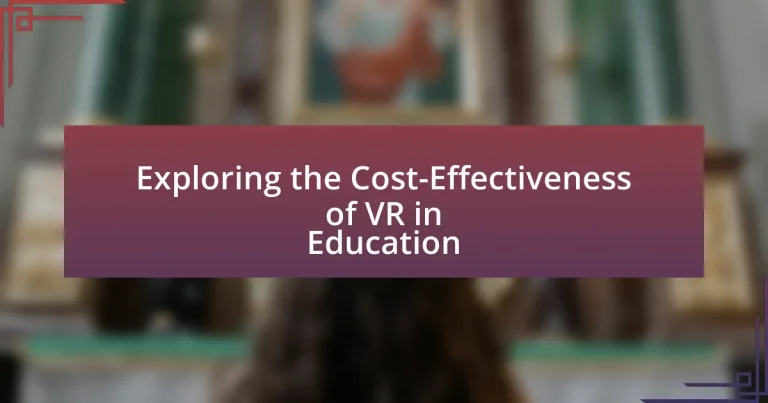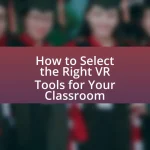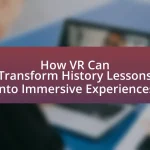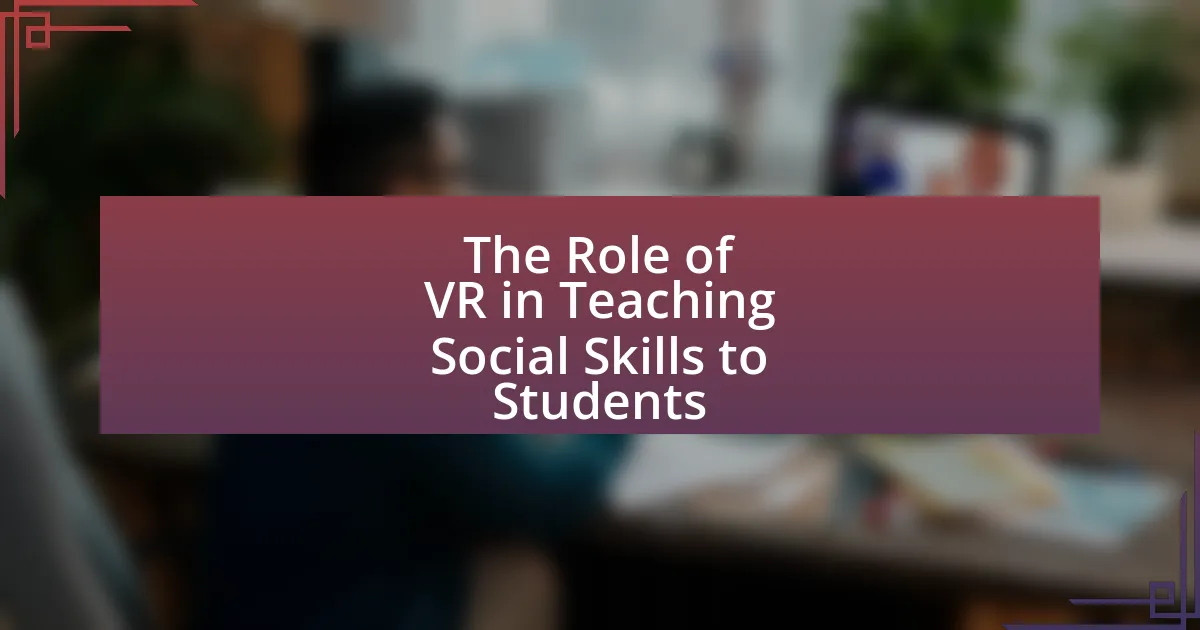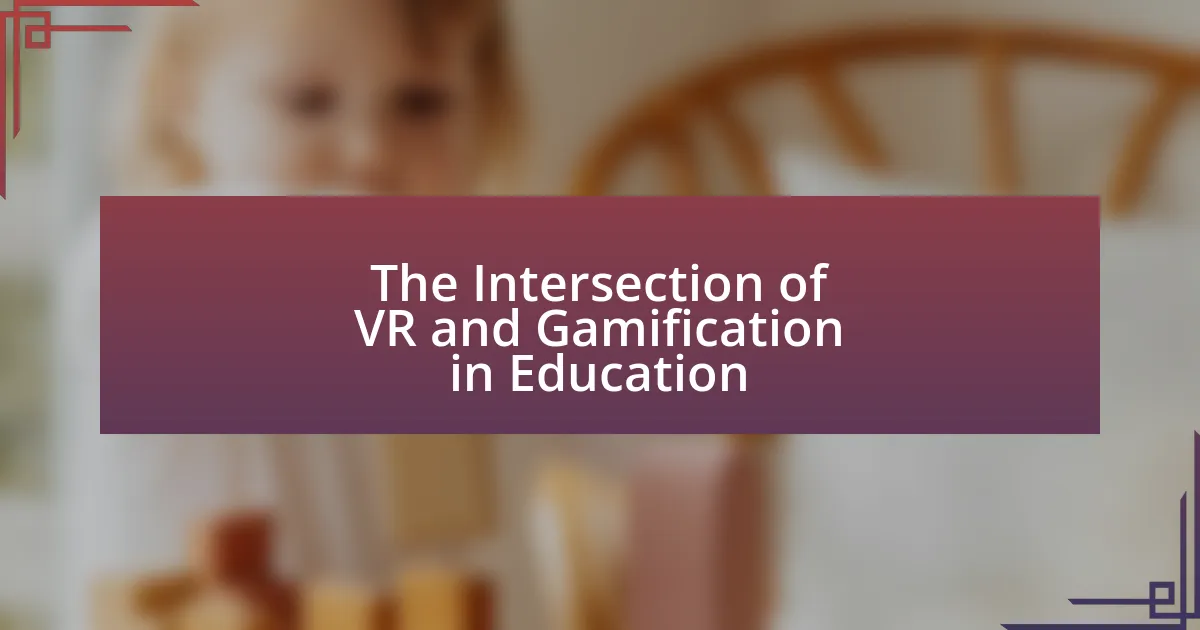The article explores the cost-effectiveness of virtual reality (VR) in education, highlighting its potential to enhance learning outcomes while reducing long-term educational costs. It defines cost-effectiveness in this context as the economic value of implementing VR technologies compared to traditional methods, focusing on metrics such as return on investment, engagement levels, and learning outcomes. Key components influencing cost-effectiveness include initial investment, ongoing maintenance costs, and the scalability of VR solutions. The article also addresses challenges in assessing cost-effectiveness, barriers to implementation, and future trends that may impact the adoption of VR in educational settings.
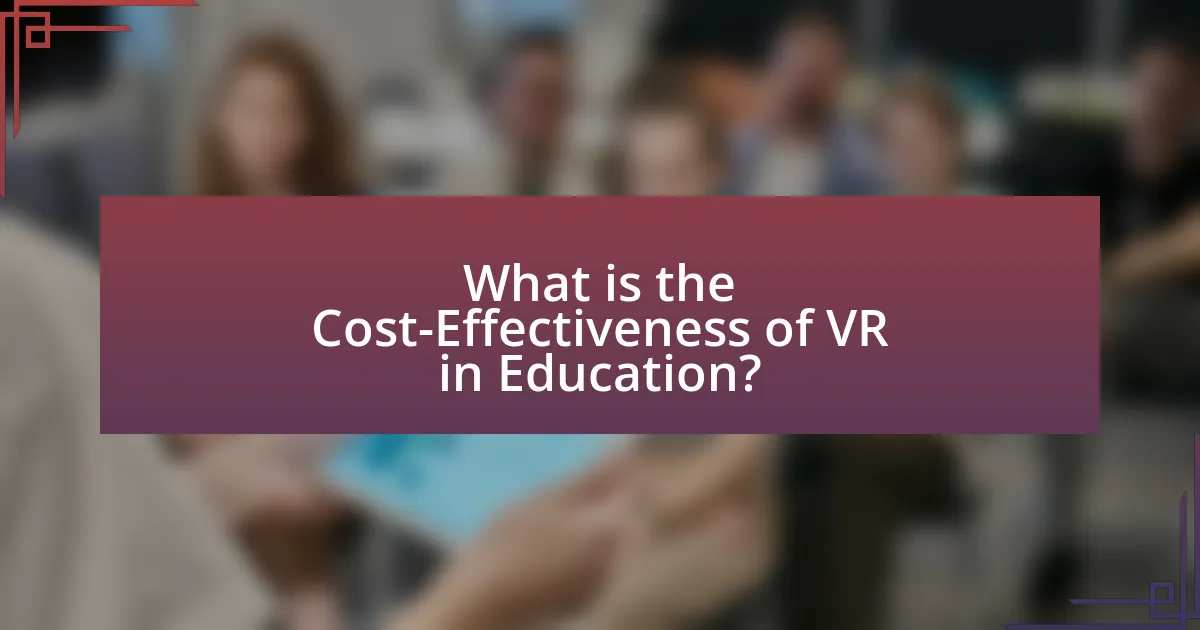
What is the Cost-Effectiveness of VR in Education?
The cost-effectiveness of virtual reality (VR) in education is significant, as it enhances learning outcomes while potentially reducing long-term educational costs. Studies indicate that VR can improve student engagement and retention rates, with a report from PwC showing that VR learners are four times more focused than in traditional classroom settings. Additionally, VR can simulate real-world scenarios, providing experiential learning opportunities that traditional methods cannot offer, which can lead to better skill acquisition and application. The initial investment in VR technology can be offset by the reduction in physical materials and the ability to conduct remote learning, making it a financially viable option for educational institutions.
How is cost-effectiveness defined in the context of VR in education?
Cost-effectiveness in the context of VR in education is defined as the assessment of the economic value of implementing virtual reality technologies compared to traditional educational methods, focusing on the outcomes achieved per unit of cost. This evaluation considers factors such as improved learning outcomes, engagement levels, and retention rates, which can be quantitatively measured against the financial investment required for VR systems. Studies have shown that VR can enhance learning experiences, with research indicating that students using VR technologies can achieve up to 75% higher retention rates compared to conventional teaching methods, thereby demonstrating a favorable cost-effectiveness ratio.
What metrics are used to measure cost-effectiveness in educational VR?
Cost-effectiveness in educational VR is measured using metrics such as return on investment (ROI), cost per learner, engagement levels, and learning outcomes. ROI quantifies the financial return relative to the investment made in VR technology, while cost per learner assesses the total expenditure divided by the number of students benefiting from the VR experience. Engagement levels are evaluated through user interaction data, indicating how effectively the VR content captures students’ attention. Learning outcomes are measured through assessments and performance metrics, demonstrating the educational impact of VR compared to traditional methods. These metrics collectively provide a comprehensive view of the cost-effectiveness of VR in educational settings.
How do these metrics compare to traditional educational methods?
Metrics related to virtual reality (VR) in education often demonstrate superior engagement and retention rates compared to traditional educational methods. Studies indicate that VR can enhance learning outcomes by providing immersive experiences that facilitate deeper understanding; for instance, a study published in the Journal of Educational Psychology found that students using VR scored 20% higher on assessments than those in conventional classrooms. Additionally, VR can reduce costs associated with physical materials and travel, as it allows for simulated experiences that would otherwise require significant resources. This cost-effectiveness, combined with improved learning metrics, positions VR as a compelling alternative to traditional educational approaches.
What are the key components that influence the cost-effectiveness of VR in education?
The key components that influence the cost-effectiveness of VR in education include initial investment costs, content development expenses, hardware and software maintenance, scalability, and the potential for improved learning outcomes. Initial investment costs encompass the price of VR headsets and software licenses, which can be substantial; for instance, high-quality VR headsets can range from $300 to $1,000 each. Content development expenses involve creating or purchasing educational VR experiences, which can vary widely based on complexity and interactivity. Hardware and software maintenance costs are ongoing and can impact long-term budget considerations. Scalability refers to the ability to implement VR across multiple classrooms or institutions, which can reduce per-student costs as more users share resources. Finally, improved learning outcomes, evidenced by studies such as those conducted by the University of Maryland, show that VR can enhance engagement and retention, potentially leading to better educational results and justifying the initial investment.
What initial investments are required for implementing VR in educational settings?
Implementing VR in educational settings requires initial investments in hardware, software, and training. Specifically, schools need to purchase VR headsets, which can range from $300 to $1,000 each, depending on the model and capabilities. Additionally, educational institutions must invest in VR software licenses, which can cost between $1,000 and $10,000 annually, depending on the number of users and the complexity of the programs. Training for educators is also essential, with costs typically ranging from $500 to $5,000 per session, depending on the depth of training required. These investments are crucial for creating an effective VR learning environment that enhances student engagement and learning outcomes.
How do ongoing maintenance and operational costs impact overall cost-effectiveness?
Ongoing maintenance and operational costs significantly reduce overall cost-effectiveness in virtual reality (VR) education. These costs include software updates, hardware repairs, and technical support, which can accumulate over time and offset initial investment savings. For instance, a study by the International Society for Technology in Education found that schools implementing VR systems faced an average annual maintenance cost of 15-20% of the initial purchase price, which can lead to budget constraints and limit the scalability of VR programs. Therefore, high ongoing costs can diminish the long-term financial viability of VR in educational settings.
What are the potential benefits of using VR in education?
The potential benefits of using VR in education include enhanced engagement, improved retention of information, and the ability to simulate real-world experiences. Research indicates that immersive VR environments can increase student motivation and participation, leading to a 30% improvement in learning outcomes compared to traditional methods. Additionally, VR allows for experiential learning, where students can practice skills in a safe, controlled setting, which is particularly beneficial in fields such as medicine and engineering. A study by the University of Maryland found that students using VR for learning retained information 40% better than those who learned through conventional means.
How does VR enhance student engagement and learning outcomes?
VR enhances student engagement and learning outcomes by providing immersive, interactive experiences that facilitate deeper understanding of complex subjects. Research indicates that students using VR technology demonstrate increased motivation and retention of information, as they can visualize and interact with content in a three-dimensional space. A study published in the Journal of Educational Technology & Society found that students who engaged with VR environments scored 20% higher on assessments compared to those using traditional learning methods, highlighting the effectiveness of VR in improving academic performance.
What long-term savings can be realized through the use of VR in educational institutions?
The long-term savings realized through the use of VR in educational institutions include reduced costs for physical materials, lower facility maintenance expenses, and decreased travel costs for field trips. By utilizing VR, institutions can eliminate the need for physical textbooks and lab equipment, which can save thousands annually. For instance, a study by PwC found that VR training can reduce training time by up to 40%, leading to significant savings in instructional hours and associated costs. Additionally, VR allows for immersive experiences without the need for travel, further cutting down on expenses related to transportation and accommodation for students and staff.
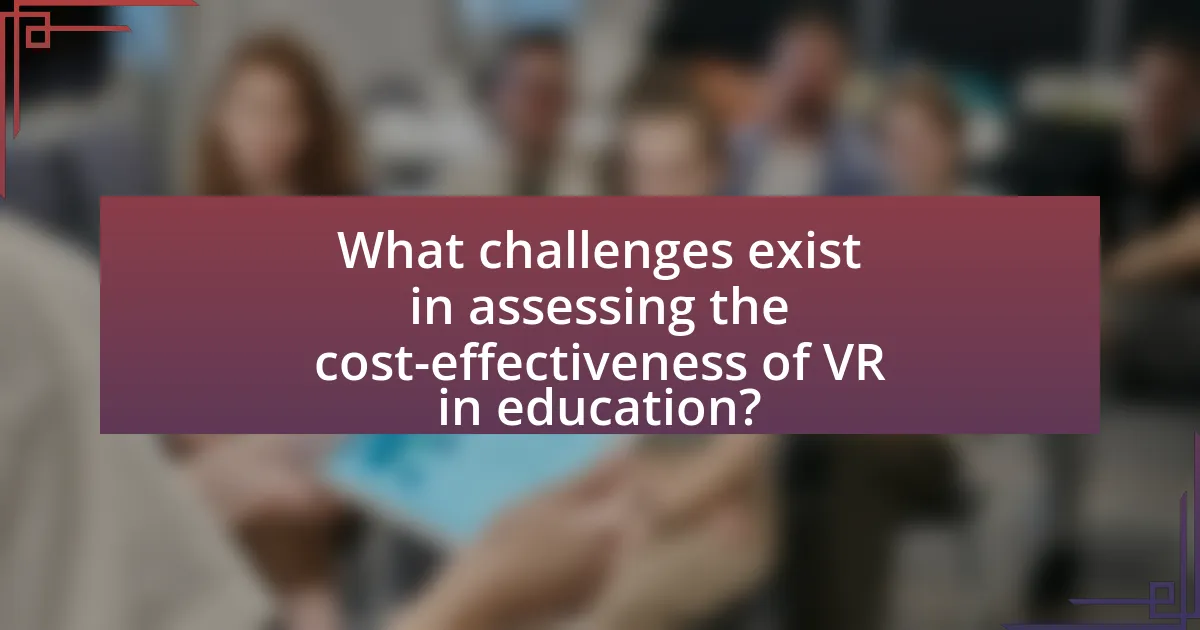
What challenges exist in assessing the cost-effectiveness of VR in education?
Assessing the cost-effectiveness of VR in education faces several challenges, primarily due to the difficulty in quantifying both direct and indirect costs and benefits. One significant challenge is the lack of standardized metrics for evaluating educational outcomes associated with VR, making it hard to compare VR programs with traditional methods. Additionally, the initial investment in VR technology can be substantial, but long-term benefits may not be immediately apparent, complicating the assessment of return on investment. Furthermore, variations in implementation across different educational settings can lead to inconsistent results, hindering the ability to generalize findings. Studies have shown that while VR can enhance engagement and learning outcomes, quantifying these improvements in monetary terms remains complex, as evidenced by research from the University of Maryland, which highlights the need for comprehensive evaluation frameworks to accurately assess cost-effectiveness.
What are the common barriers to implementing VR in educational environments?
Common barriers to implementing VR in educational environments include high costs, lack of technical infrastructure, insufficient training for educators, and limited content availability. High costs are a significant concern, as schools may struggle to afford the necessary hardware and software, with VR headsets often priced between $300 to $1,000 each. Lack of technical infrastructure, such as inadequate internet bandwidth and insufficient computer systems, can hinder effective VR deployment. Additionally, educators often require specialized training to effectively integrate VR into their teaching practices, which is frequently lacking. Finally, the limited availability of quality educational content tailored for VR can restrict its use in classrooms, making it challenging for educators to find suitable resources.
How do technological limitations affect the cost-effectiveness of VR in education?
Technological limitations significantly reduce the cost-effectiveness of VR in education by increasing initial investment and maintenance costs. For instance, high-quality VR systems require expensive hardware, such as advanced headsets and computers, which can exceed thousands of dollars per unit. Additionally, software development for educational VR experiences often necessitates specialized skills and resources, further driving up costs. A study by the International Society for Technology in Education found that schools face budget constraints that limit their ability to adopt and maintain VR technologies, ultimately hindering widespread implementation and scalability. Thus, these technological barriers lead to a less favorable cost-benefit ratio in educational settings.
What role does teacher training play in the successful adoption of VR technologies?
Teacher training is crucial for the successful adoption of VR technologies in education as it equips educators with the necessary skills and knowledge to effectively integrate these tools into their teaching practices. Research indicates that teachers who receive comprehensive training in VR are more likely to implement the technology effectively, leading to enhanced student engagement and learning outcomes. For instance, a study by the International Society for Technology in Education found that 78% of teachers who underwent specialized VR training reported increased confidence in using the technology in their classrooms. This correlation between teacher training and effective VR adoption underscores the importance of investing in professional development to maximize the benefits of VR in educational settings.
How do different educational contexts influence the cost-effectiveness of VR?
Different educational contexts significantly influence the cost-effectiveness of virtual reality (VR) by determining the scale of implementation, the specific learning outcomes desired, and the resources available. For instance, in K-12 settings, VR can enhance engagement and experiential learning, but the initial investment in hardware and software may be high relative to the budget constraints typical in these institutions. Conversely, higher education institutions often have more funding and can justify the costs of VR for specialized training, such as medical simulations, where the return on investment is measurable through improved student performance and reduced training time. Research indicates that VR training in medical education can lead to a 30% increase in skill acquisition compared to traditional methods, demonstrating its cost-effectiveness in contexts where precise skills are critical. Thus, the educational context shapes both the financial feasibility and the potential benefits of VR, influencing its overall cost-effectiveness.
What differences exist between K-12 and higher education in terms of VR implementation costs?
K-12 education typically incurs lower VR implementation costs compared to higher education. This difference arises from K-12 institutions often utilizing existing infrastructure and resources, which reduces the need for extensive investment in new technology. For instance, K-12 schools may leverage lower-cost VR solutions and focus on curriculum-aligned applications, while higher education institutions often require more sophisticated, specialized VR systems for advanced research and training, leading to higher expenses. Additionally, higher education institutions may invest in custom VR content development, which significantly increases costs, whereas K-12 schools often use off-the-shelf VR educational tools.
How does the subject matter impact the effectiveness and cost of VR applications?
The subject matter significantly impacts the effectiveness and cost of VR applications in education by determining the relevance and engagement level of the content delivered. When the subject matter aligns closely with educational objectives, it enhances learner engagement and retention, leading to more effective learning outcomes. For instance, a study by Radianti et al. (2020) published in the Journal of Educational Technology & Society found that immersive VR experiences tailored to specific subjects, such as science or history, resulted in higher student satisfaction and knowledge retention compared to traditional methods. Conversely, if the subject matter is poorly chosen or lacks relevance, it can lead to decreased engagement and increased costs due to the need for additional resources or redesign efforts. Thus, the alignment of subject matter with educational goals directly influences both the effectiveness and cost-efficiency of VR applications in educational settings.
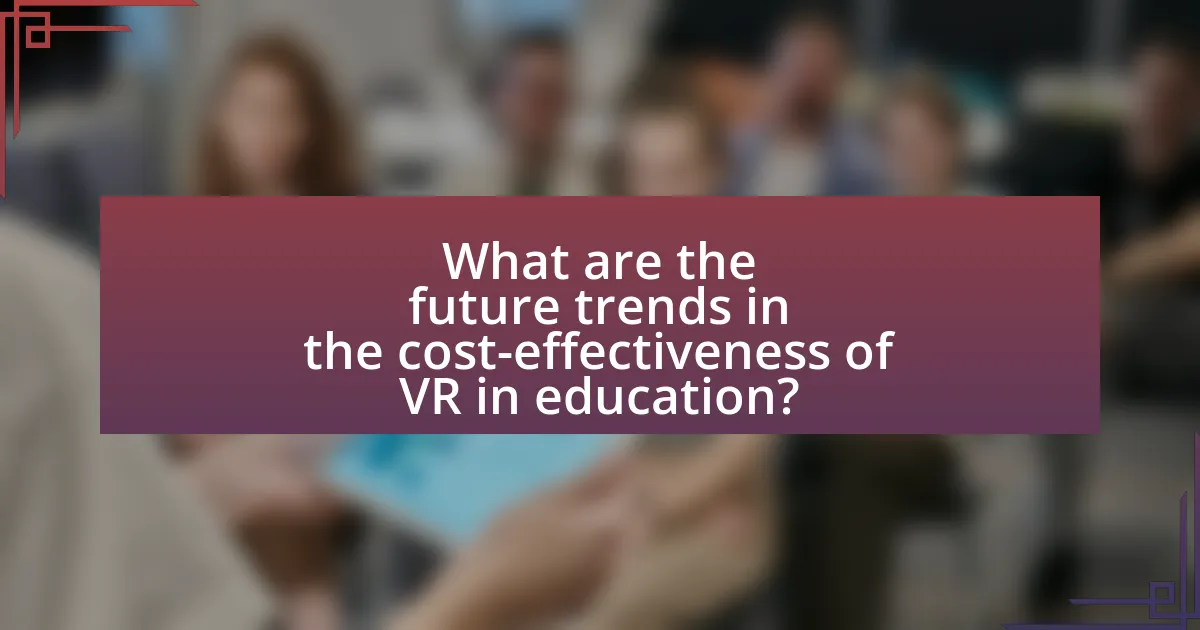
What are the future trends in the cost-effectiveness of VR in education?
Future trends in the cost-effectiveness of VR in education indicate a significant reduction in costs due to advancements in technology and increased accessibility. As VR hardware becomes more affordable and software development costs decrease, educational institutions can implement VR solutions without substantial financial burdens. For instance, the price of VR headsets has dropped significantly, with devices like the Oculus Quest 2 priced around $299, making them accessible for classroom use. Additionally, the rise of cloud-based VR platforms allows for scalable solutions that reduce the need for expensive infrastructure. Research from the International Society for Technology in Education (ISTE) highlights that VR can enhance learning outcomes while potentially lowering long-term costs associated with traditional educational methods.
How is the market for educational VR expected to evolve in the coming years?
The market for educational VR is expected to grow significantly in the coming years, driven by advancements in technology and increasing adoption in educational institutions. According to a report by ResearchAndMarkets, the global educational VR market is projected to reach approximately $13 billion by 2026, growing at a compound annual growth rate (CAGR) of around 42%. This growth is fueled by the rising demand for immersive learning experiences, which enhance student engagement and retention. Additionally, the integration of VR in curricula is becoming more prevalent, as educators recognize its potential to provide practical, hands-on experiences that traditional methods cannot offer.
What innovations are likely to reduce costs and improve effectiveness in VR education?
Innovations such as cloud-based VR platforms, AI-driven personalized learning, and the use of open-source VR content are likely to reduce costs and improve effectiveness in VR education. Cloud-based platforms eliminate the need for expensive hardware by allowing users to access VR experiences through the internet, significantly lowering infrastructure costs. AI-driven personalized learning adapts educational content to individual student needs, enhancing engagement and retention, which leads to better educational outcomes. Additionally, open-source VR content fosters collaboration and resource sharing among educators, reducing development costs and increasing the availability of diverse learning materials. These innovations collectively contribute to a more efficient and cost-effective VR educational landscape.
How might policy changes influence the adoption of VR in educational settings?
Policy changes can significantly influence the adoption of VR in educational settings by providing funding, establishing standards, and promoting integration into curricula. For instance, government initiatives that allocate budgetary resources for technology in schools can facilitate the purchase of VR equipment and software, making it more accessible for educators. Additionally, policies that set guidelines for the effective use of VR in classrooms can help educators understand best practices and enhance their teaching methods. Research from the International Society for Technology in Education indicates that when policies support technology integration, schools are more likely to adopt innovative tools like VR, leading to improved learning outcomes.
What best practices can educators follow to maximize the cost-effectiveness of VR in education?
Educators can maximize the cost-effectiveness of VR in education by implementing a strategic approach that includes careful selection of VR content, collaboration with other institutions, and ongoing assessment of VR’s impact on learning outcomes. Selecting high-quality, curriculum-aligned VR content ensures that resources are utilized effectively, as studies show that targeted VR experiences can enhance engagement and retention (Fowler, 2020, Journal of Educational Technology). Collaborating with other educational institutions allows for shared resources and reduced costs, as schools can pool funds to purchase VR equipment and software. Additionally, conducting regular assessments of VR’s effectiveness in achieving educational goals helps educators refine their approach and ensure that investments yield positive results, as evidenced by research indicating that continuous evaluation leads to improved educational practices (Higgins et al., 2019, Educational Research Review).
How can institutions effectively evaluate and select VR programs for their needs?
Institutions can effectively evaluate and select VR programs by establishing clear criteria based on educational objectives, user experience, and cost-effectiveness. First, institutions should define their specific educational goals, such as improving engagement or enhancing skill acquisition, which will guide the selection process. Next, they should assess the user experience by conducting trials or gathering feedback from potential users to ensure the program is intuitive and engaging. Additionally, institutions must analyze the cost-effectiveness of each program by comparing the costs of implementation and maintenance against the expected educational outcomes. Research indicates that VR programs can lead to improved learning outcomes, with studies showing a 76% increase in knowledge retention compared to traditional methods (Freitas & Leite, 2020, “The Impact of Virtual Reality on Learning Outcomes”). By combining these evaluation methods, institutions can make informed decisions that align with their educational needs and budget constraints.
What strategies can be employed to ensure a sustainable VR implementation in education?
To ensure a sustainable VR implementation in education, institutions should adopt a multi-faceted approach that includes continuous training for educators, integration of VR into existing curricula, and regular assessment of VR tools’ effectiveness. Continuous training equips educators with the necessary skills to effectively utilize VR technology, thereby enhancing teaching quality. Integrating VR into existing curricula ensures that the technology complements traditional learning methods, making it more relevant and effective. Regular assessments, supported by data on student engagement and learning outcomes, help in refining VR applications and ensuring they meet educational goals. Research indicates that schools that implement ongoing professional development and curriculum integration see higher rates of successful VR adoption (Huang et al., 2020, “The Impact of Virtual Reality on Education: A Review of the Literature,” Journal of Educational Technology).
